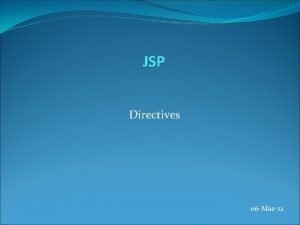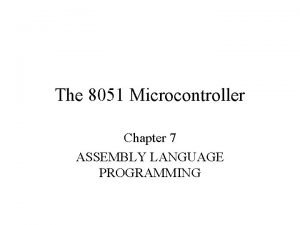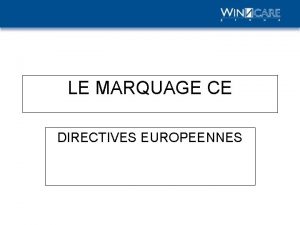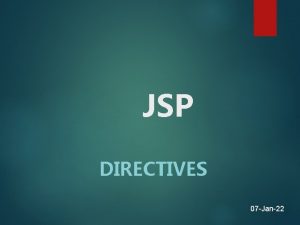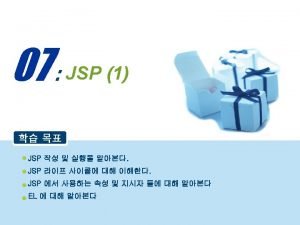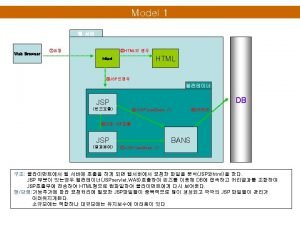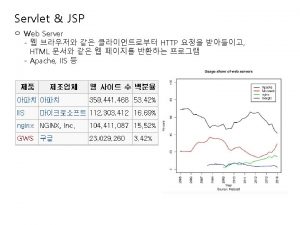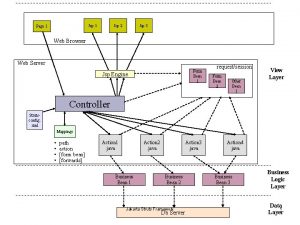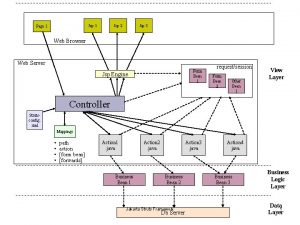JSP Directives 06 Mar21 JSP Directives JSP directives














- Slides: 14

JSP Directives 06 -Mar-21

JSP Directives: JSP directives provide directions and instructions to the container, telling it how to handle certain aspects of JSP processing. A JSP directive affects the overall structure of the servlet class. It usually has the following form: <%@ directive attribute="value" %> Directives can have a number of attributes which you can list down as key-value pairs and separated by commas. The blanks between the @ symbol and the directive name, and between the last attribute and the closing %>, are optional. There are three types of directive tag: Directive Description <%@ page. . . %> Defines page-dependent attributes, such as scripting language, error page, and buffering requirements. <%@ include. . . %> Includes a file during the translation phase. <%@ taglib. . . %> Declares a tag library, containing custom actions, used in the page

Directives affect the servlet class itself A directive has the form: <%@ directive attribute="value" %> or <%@ directive attribute 1="value 1" attribute 2="value 2". . . attribute. N="value. N" %> The most useful directive is page, which lets you import packages Example: <%@ page import="java. util. *" %> 3

The page Directive: The page directive is used to provide instructions to the container that pertain to the current JSP page. You may code page directives anywhere in your JSP page. By convention, page directives are coded at the top of the JSP page. Following is the basic syntax of page directive: <%@ page attribute="value" %> You can write XML equivalent of the above syntax as follows: <jsp: directive. page attribute="value" />

The page Directive: Following is the list of attributes associated with page directive: Attribute Purpose buffer Specifies a buffering model for the output stream. auto. Flush Controls the behavior of the servlet output buffer. content. Type Defines the character encoding scheme. error. Page Defines the URL of another JSP that reports on Java unchecked runtime exceptions. is. Error. Page Indicates if this JSP page is a URL specified by another JSP page's error. Page attribute. extends Specifies a superclass that the generated servlet must extend import Specifies a list of packages or classes for use in the JSP as the Java import statement does for Java classes. info Defines a string that can be accessed with the servlet's get. Servlet. Info() method. is. Thread. Safe Defines the threading model for the generated servlet. language Defines the programming language used in the JSP page. session Specifies whether or not the JSP page participates in HTTP sessions is. ELIgnored Specifies whether or not EL expression within the JSP page will be ignored. is. Scripting. Enabled Determines if scripting elements are allowed for use.

Error Page in JSP Useful to have an own error page Catching uncaught exceptions at runtime Using an error page in a JSP <%@ page error. Page="/util/errorpage. jsp" %> A JSP error page <%@ page is. Error. Page="true" … % > <html> <head><title>JSP Error Page</title></head> … 6

Page Directive <%@ page import="package. class" %> <%@ page import="java. util. *" %> <%@ page content. Type="text/html" %> <% response. set. Content. Type("text/html"); %> 7

The include Directive: The include directive is used to include a file during the translation phase. This directive tells the container to merge the content of other external files with the current JSP during the translation phase. You may code include directives anywhere in your JSP page. The general usage form of this directive is as follows: <%@ include file="relative url" > The filename in the include directive is actually a relative URL. If you just specify a filename with no associated path, the JSP compiler assumes that the file is in the same directory as your JSP. You can write XML equivalent of the above syntax as follows: <jsp: directive. include file="relative url" />

Include Directive <%@ include file="Relative URL"> Included at Translation time May contain JSP code such as response header settings, field definitions, etc. . . that affect the main page 9

The include directive inserts another file into the file being parsed The included file is treated as just more JSP, hence it can include static HTML, scripting elements, actions, and directives Syntax: <%@ include file="URL " %> The URL is treated as relative to the JSP page If the URL begins with a slash, it is treated as relative to the home directory of the Web server The include directive is especially useful for inserting things like navigation bars 10

The taglib Directive: The Java. Server Pages API allows you to define custom JSP tags that look like HTML or XML tags and a tag library is a set of user-defined tags that implement custom behavior. The taglib directive declares that your JSP page uses a set of custom tags, identifies the location of the library, and provides a means for identifying the custom tags in your JSP page. The taglib directive follows the following syntax: <%@ taglib uri="uri" prefix="prefix. Of. Tag" > Where the uri attribute value resolves to a location the container understands and the prefix attribute informs a container what bits of markup are custom actions. You can write XML equivalent of the above syntax as follows: <jsp: directive. taglib uri="uri" prefix="prefix. Of. Tag" /> When you use a custom tag, it is typically of the form <prefix: tagname>. The prefix is the same as the prefix you specify in the taglib directive, and the

The taglib Directive: Example: For example, suppose the custlib tag library contains a tag called hello. If you wanted to use the hello tag with a prefix of mytag, your tag would be <mytag: hello> and it will be used in your JSP file as follows: <%@ taglib uri="http: //www. example. com/custlib" prefix="mytag" %> <html> <body> <mytag: hello/> </body> </html> We would be able to call another piece of code using <mytag: hello>. We will see how to develop our custom tags and how to use them in a separate session.

<%@ Directive %> <%@ page content. Type="text/html" %> <%@ taglib prefix="c" uri="http: //java. sun. com/jstl/core" %> <html> <head> <title>JSP is Easy</title> </head> <body bgcolor="white"> <h 1>JSP is as easy as. . . </h 1> <%-- Calculate the sum of 1 + 2 + 3 dynamically – JSP Comment--%> 1 + 2 + 3 = <c: out value="${1 + 2 + 3}" /> </body> </html> 13

THANK YOU…
 Page directive in jsp
Page directive in jsp Assembly directives of 8086
Assembly directives of 8086 What is discrimination
What is discrimination Accounting and auditing board of ethiopia
Accounting and auditing board of ethiopia Equ directive in 8051
Equ directive in 8051 Iec directives
Iec directives Nws directives
Nws directives Limitations of advance directives
Limitations of advance directives Ce directives
Ce directives Idph advance directives
Idph advance directives What are the types of advance directives
What are the types of advance directives Fsis directives
Fsis directives Forest service directives
Forest service directives Swmbh
Swmbh New approach directives
New approach directives
